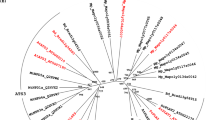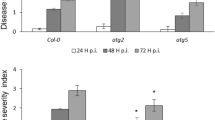Abstract
Tomato (Solanum lycopersicum L.) ARGINASE2 (ARG2) and THREONINE DEAMINASE2 (TD2) are involved in plant defense. These enzymes act in the midgut of herbivores fed on tomato plants to degrade the essential amino acids Arg and Thr, respectively. Although it has been demonstrated that overexpression of the SlARG2 gene in tomato enhanced its resistance against M. sexta larvae, knock-down the expression of SlTD2 reduced the resistance of tomato to lepidopteran herbivores; it remains unclear whether overexpression of SlTD2 could enhance the resistance of the host plants to herbivores, or whether combined overexpression of SlARG2 and SlTD2 could lead to synergistically enhanced resistance to insects. Here, we generated transgenic Arabidopsis plants overexpressing SlARG2 (SlARG2 OE) and SlTD2 (SlTD2 OE) individually as well as in combination (SlARG2-SlTD2 OE). Overexpression of these genes did not affect Arabidopsis development, seed yield, or Arg and Thr content. Insect-feeding bioassay was performed by feeding diamondback moth (Plutella xylostella L.) larvae on detached leaves of wild-type, SlARG2 OE, SlTD2 OE, and SlARG2-SlTD2 OE plants. Larvae fed on SlARG2 OE leaves showed approximately 31% to 35% reduction in weight and 6% to 10% reduction in survival rate compared to those fed on wild-type leaves. Although larvae fed on SlTD2 OE leaves showed no reduction in survival rate, they gained less weight. Whereas larvae fed on SlARG2-SlTD2 OE leaves showed neither reduction in weight nor reduction in survival rate. We further investigated the arginase enzymatic activity of the SlARG2 OE and SlARG2-SlTD2 OE transgenic plants. The SlARG2 OE line most resistant to diamondback moth larvae displayed the highest arginase activity. Our data indicate that overexpression of SlARG2 or SlTD2 in Arabidopsis can enhance its resistance against diamondback moth, whereas combined overexpression of SlARG2 and SlTD2 did not generate synergistically increased resistance to diamondback moth.




Similar content being viewed by others
References
Brauc, S., De Vooght, E., Claeys, M., Geuns, J. M., Höfte, M., & Angenon, G. (2012). Overexpression of arginase in Arabidopsis thaliana influences defence responses against Botrytis cinerea. Plant Biology, 14, 39–45.
Brownfield, D. L., Todd, C. D., & Deyholos, M. K. (2008). Analysis of Arabidopsis arginase gene transcription patterns indicates specific biological functions for recently diverged paralogs. Plant Molecular Biology, 67, 429–440.
Campos, M. L., Yoshida, Y., Major, I. T., de Oliveira Ferreira, D., Weraduwage, S. M., Froehlich, J. E., et al. (2016). Reviring of jasmonate and phytochrome B signaling uncouples plant growth-defense tradeoffs. Nature Communications, 7, 12570.
Chen, H., McCaig, B. C., Melotto, M., He, S. Y., & Howe, G. A. (2004). Regulation of plant arginase by wounding, jasmonate, and the phytotoxin coronatine. The Journal of Biological Chemistry, 279(44), 45998–46007.
Chen, H., Wilkerson, C. G., Kuchar, J. A., Phinney, B. S., & Howe, G. A. (2005). Jasmonate-inducible plant enzymes degrade essential amino acids in the herbivore midgut. Proceedings of the National Academy of Sciences of the United States of America, 102(52), 19237–19242.
Chen, H., Gonzales-Vigil, E., Wilkerson, C. G., & Howe, G. A. (2007). Stability of plant defense proteins in the gut of insect herbivores. Plant Physiology, 143(4), 1954–1967.
Chung, H. S., Koo, A. J., Gao, X., Jayanty, S., Thines, B., Jones, A. D., et al. (2008). Regulation and function of Arabidopsis JASMONATE ZIM-domain genes in response to wounding and herbivory. Plant Physiology, 146(3), 952–964.
Clough, S. J., & Bent, A. F. (1998). Floral dip: A simplified method for Agrobacterium- mediated transformation of Arabidopsis thaliana. The Plant Journal, 16(6), 735–743.
Duffey, S. S., & Stout, M. J. (1996). Antinutritive and toxic components of plant defense against insects. Archives of Insect Biochemistry and Physiology, 32(32), 3–37.
Edwards, K., Johnstone, C., & Thompson, C. (1991). A simple and rapid method for the preparation of plant genomic DNA for PCR analysis. Nucleic Acids Research, 19(6), 1349.
Felton, G. W. (1996). Nutritive quality of plant protein: Sources of variation and insect herbivore responses. Archives of Insect Biochemistry and Physiology, 32, 107–130.
Felton, G. W. (2005). Indigestion is a plant's best defense. Proceedings of the National Academy of Sciences of the United States of America, 102(52), 18771–18772.
Felton, G. W., Bi, J. L., Summers, C. B., Mueller, A. J., & Duffey, S. S. (1994). Potential role of lipoxygenases in defense against insect herbivory. Journal of Chemical Ecology, 20(3), 651–666.
Goldraij, A., & Polacco, J. C. (2000). Arginine degradation by arginase in mitochondria of soybean seedling cotyledons. Planta, 210(4), 652–658.
Gonzales-Vigil, E., Bianchetti, C. M., Phillips Jr., G. N., & Howe, G. A. (2011). Adaptive evolution of threonine deaminase in plant defense against insect herbivores. Proceedings of the National Academy of Sciences of the United States of America, 108(14), 5897–5902.
Halitschke, R., & Baldwin, I. T. (2004). Jasmonates and related compounds in plant-insect interactions. Journal of Plant Growth Regulation, 23(3), 238–245.
Hildmann, T., Ebneth, M., Pena-Cortes, H., Sanchez-Serrano, J. J., Willmitzer, L., & Prat, S. (1992). General roles of abscisic and jasmonic acids in gene activation as a result of mechanical wounding. Plant Cell, 4(9), 1157–1170.
Kessler, A., Halitschke, R., & Baldwin, I. T. (2004). Silencing the jasmonate cascade: Induced plant defenses and insect populations. Science, 305(5684), 665–668.
Li, L., Zhao, Y., McCaig, B. C., Wingered, B. A., Wang, J., Whalon, M. E., et al. (2004). The tomato homolog of CORONATINE-INSENSITIVE1 is required for the maternal control of seed maturation, jasmonate-signaled defense responses, and glandular trichome development. Plant Cell, 16, 126–143.
Li, Z., Feng, X., Liu, S. S., You, M., & Furlong, M. J. (2016). Biology, ecology, and management of the diamondback moth in China. Annual Review of Entomology, 61, 277–296.
Major, I. T., Yoshida, Y., Campos, M. L., Kapali, G., Xin, X. F., Sugimoto, K., et al. (2017). Regulation of growth-defense balance by the JASMONATE ZIM-DOMAIN (JAZ)-MYC transcriptional module. New Phytol, doi: https://doi.org/10.1111/nph.14638. [Epub ahead of print].
Reymond, P., Bodenhausen, N., Van Poecke, R. M., Krishnamurthy, V., Dicke, M., & Farmer, E. E. (2004). A conserved transcript pattern in response to a specialist and a generalist herbivore. Plant Cell, 16(11), 3132–3147.
Samach, A., Hareven, D., Gutfinger, T., Ken-Dror, S., & Lifschitz, E. (1991). Biosynthetic threonine deaminase gene of tomato: Isolation, structure, and upregulation in floral organs. Proceedings of the National Academy of Sciences of the United States of America, 88(7), 2678–2682.
Samach, A., Broday, L., Hareven, D., & Lifschitz, E. (1995). Expression of an amino acid biosynthesis gene in tomato flowers: Developmental upregulation and MeJA response are parenchyma-specific and mutually compatible. The Plant Journal, 8(3), 391–406.
Shakeel, M., Farooq, M., Nasim, W., Akram, W., Khan, F. Z. A., Jaleel, W., et al. (2017). Environment polluting conventional chemical control compared to an environmentally friendly IPM approach for control of diamondback moth, Plutella xylostella (L.) in China: A review. Environmental Science and Pollution Research International, 24(17), 14537–14550.
Zhang, C. H., Hein, T. W., Wang, W., Miller, M. W., Fossum, T. W., McDonald, M. M., et al. (2004). Upregulation of vascular arginase in hypertension decreases nitric oxide-mediated dilation of coronary arterioles. Hypertension, 44(6), 935–943.
Zhang, X., Shen, L., Li, F., Meng, D., & Sheng, J. (2011). Methyl salicylate-induced arginine catabolism is associated with up-regulation of polyamine and nitric oxide levels and improves chilling tolerance in cherry tomato fruit. Journal of Agricultural and Food Chemistry, 59(17), 9351–9357.
Acknowledgements
We thank Gregg A. Howe for providing the pB2GW7-ARG2 and pBI121-TD2 plasmids, Nam-Hai Chua for providing the pBA002 plasmid, Shaohui Yang and Jiehua Wang for providing diamondback moth eggs, Tongmei Xia for helping with amino acid measurement. This work was supported by the National Natural Science Foundation of China (31570247 and 31460453); the Major Technological Program on Cultivation of New Varieties of Genetically Modified Organisms (NO. 2011ZX08004-004); and the Natural Science Foundation of Tianjin (No. 14JCYBJC41200).
Author information
Authors and Affiliations
Contributions
SM conceived and designed the experiments. QZ constructed the SlARG2-SlTD2 OE vector; generated SlARG2 OE, SlTD2 OE, and SlARG2-SlTD2 OE transgenic Arabidopsis plants; and performed the phenotypic analysis of these plants. HG performed the insect bioassay and arginase activity assay; and analyzed the amino acid content. HG, QZ, XY, and SM analyzed the data. XY and HG drafted the manuscript; SM rewrote most part of the manuscript.
Corresponding author
Additional information
Highlights This study demonstrates that overexpression of SlARG2 or SlTD2 increases Arabidopsis resistance against diamondback moth without affecting development, yield, and amino acid content of the transgenic plants. Therefore, this study provides a novel strategy for generating herbivore-resistant transgenic cruciferous crops.
Electronic supplementary material
ESM 1
(DOC 45 kb)
Fig. S1
Life cycle of diamondback moth (Plutella xylostella L.). (A) Eggs. (B-D) Larvae at first (B), third (C), second (arrow in D), and fourth instar (arrowhead in D). (E) Pupa. (F-G) Adult in back (F) and bottom view (G). (TIFF 4796 kb)
Fig. S2
Phenotypes of SlARG2 and SlTD2 OE seedlings. (A) Five-day-old seedling grown under 16-h light/8-h dark growth conditions. (B-D) Root and hypocotyl length of 5-day-old seedlings grown under 16-h light/8-h dark growth conditions (B, C) or in the dark (D, E). Data from three experiments are presented as the means ± SD (n = 20 for each experiment). Differences between the wild-type (WT) and transgenic lines were significant at P < 0.05 (*) or P < 0.01 (**) by Student’s t test. (TIFF 11846 kb)
Rights and permissions
About this article
Cite this article
Geng, H., Zhang, Q., Yang, X. et al. Overexpression of SlARG2 or SlTD2 in Arabidopsis enhances resistance against Plutella xylostella L.. Phytoparasitica 45, 695–705 (2017). https://doi.org/10.1007/s12600-017-0626-6
Received:
Accepted:
Published:
Issue Date:
DOI: https://doi.org/10.1007/s12600-017-0626-6




